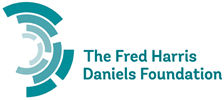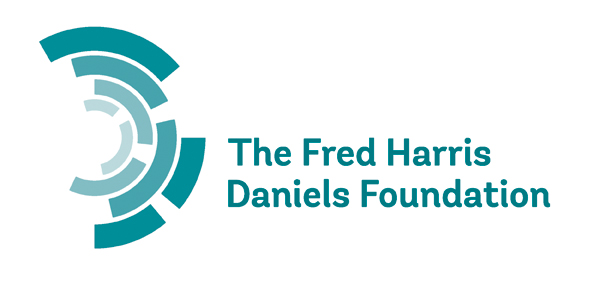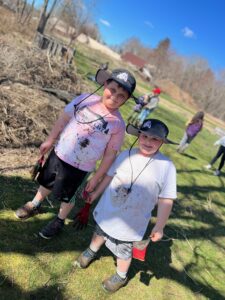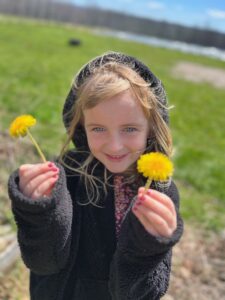25 Apr April 2024 Newsletter
April 2024 Newsletter
Welcome to the April 2024 edition of the Daniels Foundation Newsletter. In this issue, we explore the following topics. Click on the links to read the articles!
Program Spotlight: Overlook FARM (Food Awareness Resource of MA)! Overlook FARM is a working farm in Rutland, MA. The farm has deep roots within the community… Click here to read more…
Generation 2: Fred Harris Daniels, the Man Who Started it All! The American Civil War had been in full destructive mood for sixteen months when on a day in August 1862 9 year old Fred Harris Daniels stood with his father and mother and watched his two older brothers march to the Worcester train station as volunteers… Click here to read more…
Trustee Profile: Dwight Blake Jr In December 2023, I stepped into a position on the board, succeeding my father, Dwight C. Blake Sr (Raider), who had held the seat for several decades… Click here to read more…
Program Spotlight: Overlook FARM (Food Awareness Resource of MA)
by Wendy Andrews
Overlook FARM is a working farm in Rutland, MA,. The farm has deep roots within the community, and their core value is the belief that their approach to farming teaches the value of sustainable agriculture and promotes food justice to grow a healthy world.
Overlook FARM “grew “out of the Williams’ family cow farm that has been in Rutland for many generations. When the family decided to cease operations, as farming/cattle raising was a dying breed, the Heifer project began and in 2017, and Overlook took over to start farming on the land once again. The non-profit has grown every year since inception. They have been able to reach more people and have tried to make a difference in the lives of those less fortunate.
During 2023 they reached over 2,000 people in their programs and events, including children ages 2-13, adults and seniors. They donated close to 2,400lbs of fresh produce from their gardens as well as produce, as well as fruit from other providers in their network. The food was distributed to places in Central MA such as Friendly House, Wachusett Food Pantry, Council on Aging in Rutland, WHEAT Community Action, just to name a few. Obviously, they distribute the produce to those most in need and have added other agencies that work with the homeless and youth in crisis.
Their motto is GROW-TEACH-GIVE. They teach children, adults, and volunteers of all ages about their part in the ecosystem and where their food comes from. The overall goal is to connect with communities who are facing food insecurity. Overtime, since 2022, the Daniels Foundation has supported their mission with $12,500.
On a personal note: I hand delivered their Grant check while school vacation camp was going on and it was so rewarding to see those kids “in action”, planting flowers or playing in the mud to learning how the bees help to pollenate the flowers on the FARM.
G2 Profile: Fred Harris Daniels, the Man Who Started it All
by Bill Pettit, III
As my time on the Board is winding down, and as the Foundation celebrates its 75th anniversary, we are reprinting two articles about Fred Harris Daniels that appeared previously in this newsletter. I am most proud of each of these. As a non-writer and not even a part time history buff, putting these together required patience, diligence and creativity. The first part highlights our Daniels’ family’s contribution and sacrifice to end slavery. And the second covers the founding and funding of the Foundation.
The Civil War and the Daniels Family
The American Civil War had been in full destructive mood for sixteen months when on a day in August 1862 9 year old Fred Harris Daniels stood with his father and mother and watched his two older brothers march to the Worcester train station as volunteers in the 36th Massachusetts Volunteer Infantry, a unit of the Army of the Potomac. We can’t know what Fred was thinking, nothing survives that would tell us, but that day had to be an important moment in his life.
Fred’s father, William Pomeroy Daniels, was a contractor and lumber merchant on Grove Street in Worcester. He and his wife, Hepsy Ann Stark brought their family to Worcester from New Hampshire and would raise five children: four boys and a girl.
As Samuel A. Eliot wrote in 1911 of William Pomeroy Daniels: “… A man of vigorous character, tenacious of his opinions, benevolent and ardent in his championship of equal rights. In the stirring years of the anti-slavery agitation, he was an eager and uncompromising abolitionist.” He, no doubt, raised his children up with the same beliefs.
The boys, (men, really, since they were in their 20’s), Lt. Henry William Daniels and Private Myron Morton Daniels, would travel south for the rest of 1862 fighting in the Battle Of Fredericksburg and the sieges of Vicksburg and Jackson, spending all of 1863 fighting the various forces of the Confederacy.
Then in May 1864 the 36th Infantry would participate in the Battle of the Wilderness, which took the lives of 2246 union soldiers in just 3 days, including Fred’s brother Myron. And just a day later the 36th fought in the Battle of Spotsylvania, where 2725 union soldiers died including Lt. Henry William Daniels.
They never returned to Worcester. We will never know how William, Hepsy and Fred felt of the sacrifice made by their children and brothers, but on the public common behind Worcester’s City Hall a monument erected in 1874 is dedicated to all the 398 soldiers of Worcester who died in the war. Inscribed, and still visible, are the names Myron Morton Daniels and Henry William Daniels.
A moderately deep dive into the Industrial Revolution and the Daniels Family
Henry Ford: “the abrasive processes are basically responsible for our ability to produce cars to sell for less than a thousand dollars. Were it not for these processes these same cars would cost at least five thousand dollars, if indeed they could be made at all.”
The foundation today has a corpus of about $20 Million. It did not start out at 20 million; rather, it has grown from the original funding as a result of judicious management by all of the board members over the past 75 years. Additionally, that fund has allowed the foundation to support many great causes in Worcester with millions and millions of dollars…
Where did the original money come from?
The foundation was created in the year 1949, by the three brothers Clarence, Harold and Dwight, and they chose to name it after their father, Fred Harris Daniels.
Each of the brothers contributed to the founding fund. While the early years records are lost, it is fairly clear that the stocks that made up the original foundation came from at least two of Worcester’s major businesses: Norton Company and Riley Stoker Company.
Norton Emery Wheel Company
In 1885 Fred Harris Daniels was an original founder, stock holder and board member of Norton Emery Wheel Company. After his death in 1913 (age 60) the estate he left to his wife Sarah Lydia Daniels and children were his holdings in Norton. Even as the founder of Norton, he worked throughout his career at Washburn and Moen (later American Steel and Wire, a US Steel company). In his autobiography he emphatically states that his work at Washburn and Moen was salaried only. He had no equity stake there. And while he held numerous patents, all profits from those patents belonged to his employer, and he proudly stated that he was amply happy with his salary (which is old waspy English for “highly paid”).
What is Norton Company
Norton Emery Wheel Company was founded in Worcester in 1885. By 1962 it was known as Norton Company and “went public”. In 1988 it was purchased for cash by the French multinational firm, Sain Gobein.
Everything we rely on, food, housing, transportation, everything that powers this civilization, is possible only because of three things: petroleum, rubber and metal.
The machines that make the machines that grow and process the food, that make the 2 x 4s, roofing shingles, window and doors for the houses, that make the trucks that deliver all of that and cars and buses we use to go from our homes to the markets… are made of metal, lubricated with the petroleum and held together and tight with rubber: gaskets, o-rings, belts etc.
Without those three elements none of what we take for granted would be possible. Maybe in the future we will develop some here-to-fore unknown technology that will beam all that stuff to us in our organically grown homes but as of 1885, 1949 and today that day hasn’t arrived..
And this is where Norton Company comes into the equation: Abrasives. Today Norton Company is the world’s largest manufacture of abrasives and abrasive products. In fact, since its founding in1885 it has always lead in the industry.
Why Abrasives Matter:
To achieve the tolerances required to have the machinery work at the level of efficiency needed, abrasives are used. There is no other way to make that cam shaft, turbine blade, rotor, generator axle… without grinding or sanding to the final dimension.
The Innovation
The unique innovation of 1885 by a small group of Worcester businessmen was the envisioning of the transition from limited natural made abrasive products (sharpening stones, mill wheel stones) to unlimited manmade industrial tools: grinding wheels and sand papers which were needed to revolutionize metal working.
The founding of Norton
In the middle of the 19th century Worcester was the Silicon valley of the day… Worcester was a center of machinery, wire products and power looms and boasted large manufacturers: Washburn & Moen, Wyman-Gordon Company, American Steel & Wire, Morgan Construction. In this caldron of industrial revolutionary innovation, Fred Harris Daniels was positioned right in the middle of a sweet spot, working as an engineer at Washburn and Moen Company, the nation’s largest wire manufacturer.
In 1885 Five men: Higgins, Jeppeson, Messer, Allen, Alden saw the future and made an offer to buy Frank Norton’s Pottery works, Frank made ceramic jugs, pots and bowls. With The FB Norton Kiln works the visionaries knew it would be an ideal place to make grinding wheels, to begin the innovation process. Frank wanted $20,000 for his factory on Water St. in Worcester; however, the men could not come up with the full amount. So they asked Fred Daniels to join in and he invested $2000 which allowed them to close the deal….for which FHD received shares of the new company.
A further research breakthrough proved that FHD sold eight of his patents to his employer just before 1885 for $2500. Did he use that money to fund the purchase of Norton? There is no official record, but…
The Founding of the Foundation
All three sons inherited from their mother this Norton Company stock. Additionally, Clarence worked his entire career at Norton, Dwight worked there briefly after he graduated from Yale, and Harold held his share of Norton stock. All enjoyed the yearly dividends…
Norton was the Family business… and from FHD’s investment in 1885 came our family foundation in 1949.
Let’s consider for a moment FHD’s investment in 1885. Who was he that day? He was a 32 years old. He had not yet been promoted even to assistant general superintendent. He was a draftsman engineer. 12 years out of college. He had been married a short 2 years and they had only one child, Clarence, perhaps just a year old. $2000 in 1885 had the buying power of at least $50,000 in today’s dollars; a middle class home at that time cost $3000.
We will never know what was said but it’s fun to speculate. Did he come home one day and say to Sarah: “Honey I took the money I received from selling my patents to the company and gave it all to Milt and his chums because they have a swell idea.”
Who in their right mind at 30 years old would take apparently such a large shot in the dark? Only a true visionary would do that. I for one am pleased that at least some small part of my DNA came from FHD, a man who was not only right place right time but more importantly he was an abstract visionary. While there was no way he could foresee all the subsequent Norton innovations and growth, he knew it would be an extraordinarily good investment… enough (perhaps) to bet the farm on. Sadly, he would not live to see how good an investment it would be….
Answer to your final question:
What if you did what FHD did and bet your farm …. Yes, if you had invested $50,000 dollars in the first Apple Computer IPO in 1980 (by the way, I was 30 then, one child, salesman for Norton) you would have received 2,270 shares which with the splits over the last 30 years would become 127,272 shares and at today’s market price of Apple at $156 a share your investment would be worth $19,854,545 (not including dividends). Or if you prefer, if you invested $50,000 in Amazon, in its initial IPO in 1997, it would be worth $60,000,000 today. (By the way, these values dates from the original writing of this article in 2019. Now you do the updated math!!)
Trustee Profile: Dwight Blake Jr.
by Dwight Blake Jr.
In December 2023, I stepped into a position on the board, succeeding my father, Dwight C. Blake Sr (Raider), who had held the seat for several decades. Our family’s connection to the Foundation comes from my grandmother, Mary Daniels, who is the daughter of Dwight Clark Daniels.
Growing up in Worcester county, I attended Bancroft School from first grade through ninth grade before heading off to boarding school in Maine. Despite leaving for school, Worcester always held a special place in my heart, as it was where my childhood friends and family remained. Joining the board was a natural step for me to give back to a region that I’ve always felt connected to and where I know there are significant areas of need.
Since graduating college in 2000, I’ve called Cape Cod home. I’ve owned a small retail business since 2005 and I spend most of my days doing home restoration work in the lower Cape area. My wife Chrissy and I have a fifteen-year-old daughter, Taylor, and thirteen-year-old son, Dwight (III) who we call “Teddy”. With four cats and a five-month-old puppy, our household is never short on mouths to feed. We head out for snowboarding in the winter as regularly as possible, boating in the summer when the weather cooperates, and search in the woods for our lost golf balls on the occasions we get to go golfing.







Sorry, the comment form is closed at this time.